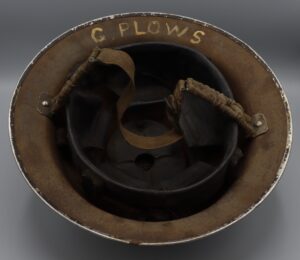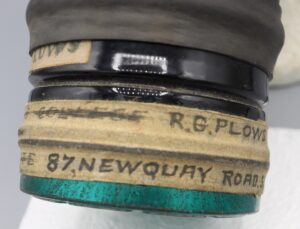Within the Second World War collection there are three different items all bearing the surname ‘Plows’.
The first item is a rust-speckled black steel helmet, with leather webbing, and a white ‘W’ printed on the front. Flipped over, we find, ‘G. Plows’, written in white paint under the wide brim.
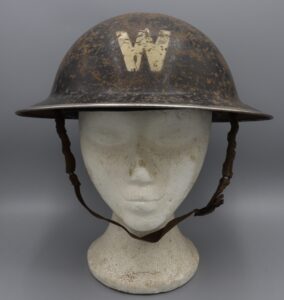
The second item is a medium-sized General Civilian Respirator, or gas mask, in a tattered and battered cardboard box, with, ‘E. M. Plows’, written in pencil on the top.
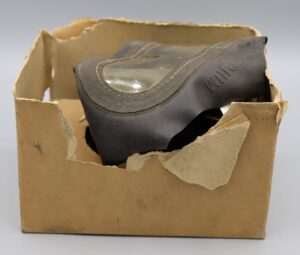
The final item is another gas mask, this time contained in a slightly rusty khaki tubular tin. Around the filter of the mask are two pieces of adhesive plaster, upon which are written, ‘R. G. Plows’, and two addresses. The first address, ‘St Dunstan’s College, Reigate’, has been crossed through and replaced with, ’87 Newquay Road, SE6’.
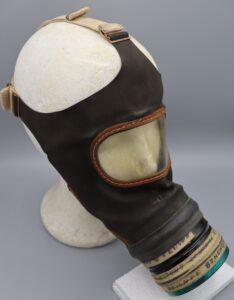
Clearly, there is some connection between these three items, and the people who owned them, but what are the stories behind them?
George Benjamin Plows
The story starts with George Benjamin Plows, born in Deptford on 3 August 1891, who many years later would go on to own and wear the steel helmet.
George’s father was George Thomas Plows, an Electrical Switchman, who was born in Salford, and his mother was Mary Roberts, born in Milton Keynes. The couple married in Saint Luke’s Church, Evelyn Street in Deptford, on 8 June 1890, and lived at 19 James Street in Deptford.
George Benjamin was their first-born child, followed by Alice May in 1893 and Albert Henry in 1896. Sadly, Albert died just a few months old, but in 1897 another daughter, Gertrude Annie E., was born. By April 1901, the family had moved to a larger property at 105 Childeric Street in Deptford. Another son, Charles Henry, arrived in 1901, but this was to be George and Mary’s last child, as Mary Plows passed away at the age of 40 in 1906.
So, George Benjamin Plows lost his mother when he was fourteen years of age, and three years later he acquired a stepmother when his father married Eliza Trattell. George also acquired three stepsiblings, as Eliza had three children of her own: Henry, a Railway Carriage Cleaner, Annie, a General Domestic Servant, and Ernest, a Store Boy at an Engineering Works.
By 1911, the family moved again, to 34 Alexandra Street in New Cross, and George Benjamin was employed as an Apprentice Engineer in the same power station where his father worked as a wireman.
George served in the Merchant Navy during the First World War, receiving the Mercantile Marine War medal and the British War medal.
George and Ethel Plows
Following his war service, George married Ethel Millicent Bishop in 1919. Ethel Millicent Bishop was born in Bethnal Green on 19 August 1898. Ethel became Ethel Millicent Plows, and it is her initials, E. M. Plows that we find on the cardboard box of the gas mask she would own twenty years later.
George and Ethel had three children: Joan Millicent, born in 1921, Raymond George, born in 1924, and John Peter, born in 1929.
The family moved from Alexandra Street to 87 Newquay Road in Catford sometime before John was born in 1929.
Second World War
The steel helmet belonging to George Benjamin Plows would have been issued to him in his role as an Air Raid Precautions (ARP) Warden. We know this because the white W printed on the helmet denotes ‘Warden’.
Following the passing of the Air Raid Precautions Act in 1937, local councils across Britain were responsible for establishing a range of organisations and procedures designed to protect civilians from the dangers of air raids.
George would have been 48 when the war started, and he would have volunteered to be an ARP Warden. His duties would have included advising people on air raid precautions, policing the night time ‘blackout’, monitoring and reporting bomb damage, and coordinating other Civil Defence services like firefighters and ambulances.
In 1938, the British Government issued every civilian (around 38 million people) with a General Civilian Respirator or ‘gas mask’ as they were commonly known. During the war it became a requirement to carry a respirator at all times. The respirator owned by Ethel Plows would have had an activated charcoal filter for gas and wool filter for dust and particles.
As we see with Ethel’s respirator, the cardboard boxes they were issued in were not particularly robust. With the requirement to carry the respirator at all times, many people opted to purchase a carrying case and many different types and styles were produced.
Given George’s position at an ARP warden, it is likely that George, Ethel, and their children would have been well practiced in putting on their respirators. Ultimately, gas was never deployed in Britain, so the respirators were never needed, but they became a familiar accessory throughout the war.
Raymond George Plows
George and Ethel’s son, Raymond, would have been 15 when the war started and we can see from his respirator that he was a pupil at St Dunstan’s College, which was based in Stanstead Road in Catford. So why does Raymond’s respirator say Reigate?
Well, in 1939 pupils at St Dunstan’s were evacuated from the perceived dangers of urban south-east London to Reigate in Surrey, where they were accommodated with local families. St Dunstan’s shared the site and facilities of Reigate Grammar School, using it in the mornings while Reigate pupils used it in the afternoons.
Raymond’s amendment to the address on his respirator shows that he returned to the family home at Newquay Road, which suggests that by the time St Dunstan’s pupils were evacuated for a second time, to South Wales in 1944, Raymond had left the School.
We know that Raymond was living at 24 Croydon Road, Catford in December 1942, because he was marginally involved in a rather sad and macabre incident.
Raymond was fishing in Lower Keston Pond on Christmas Eve, when he fished out a black leather shopping bag. Inside the bag was a ladies handbag containing an ID card, two diaries, some cosmetics, and one penny. Raymond took the bag to Bromley Police Station and the following morning, Christmas Day 1942, police dragged the lake.
At around 9.30am, the body of 46-year-old Lydia Susan Mitchell was recovered from the lake. An inquest heard that Miss Mitchell, in her role as the Manageress at a dressmaker’s in Camberwell Green, had previously taken around £270 from customers for clothing which had never been delivered. It appears that Miss Mitchell’s employers had just started to investigate this issue when she went missing. The coroner recorded a verdict of ‘suicide while temporarily of unsound mind’.
By November 1945, Raymond was back living at 87 Newquay Road in Catford when he had another brush with the law; this time of his own making. Raymond, and his friend John Rolfe, were convicted and fine 10s each for holding onto a lorry while they were cycling in Halstead near Sevenoaks.
In the summer of 1954, Raymond married Mary Couch in Bromley and the couple went on to have three sons; John, David, and Andrew.
The Plows Family
We know that George was a keen and proficient lawn bowler, and that he was also a Freemason, joining the Nelson Lodge in Kent in 1920. He passed away in Eastbourne in 1961. Ethel survived her husband by thirteen years, and passed away in Eastbourne in 1974.
Their daughter, Joan, was involved with some local charitable work, trained as a shorthand typist, and, in 1948, married a Police Constable, Walter Herbert Glenn.
Ultimately, all immediate members of the Plows family survived the war and went on to live to relatively good ages. The objects that belonged to them tell us something of a family in wartime. George, pulling on his ARP uniform and donning his steel helmet, kissing Ethel goodbye and reminding her to take her respirator with her, but also in the back of his mind not knowing what he would encounter or if either they would survive the attack.

